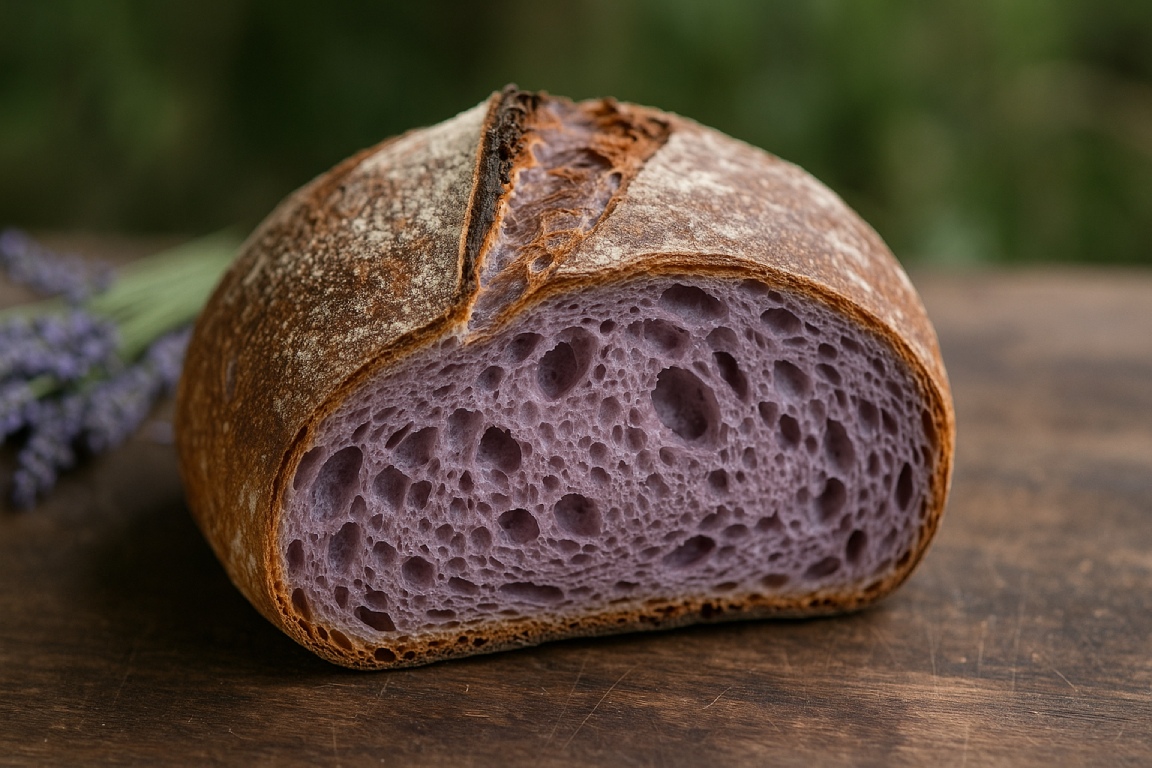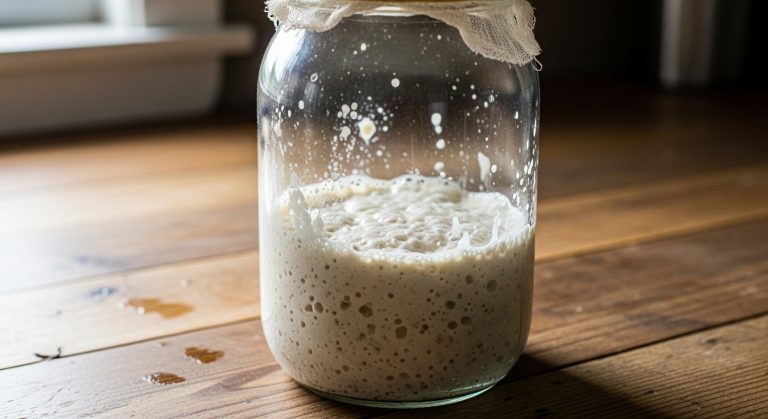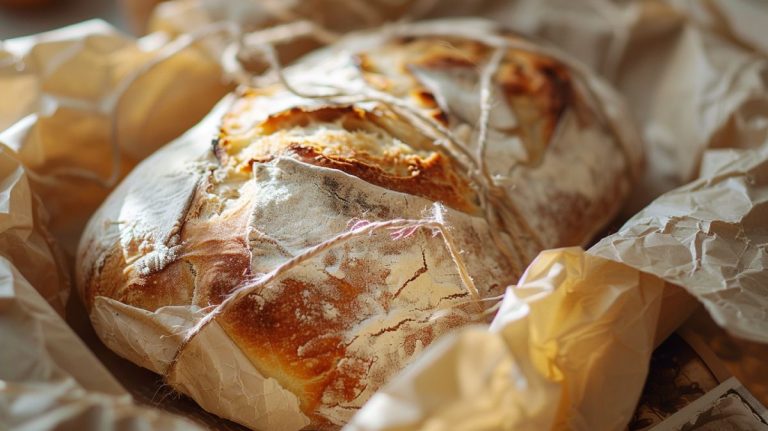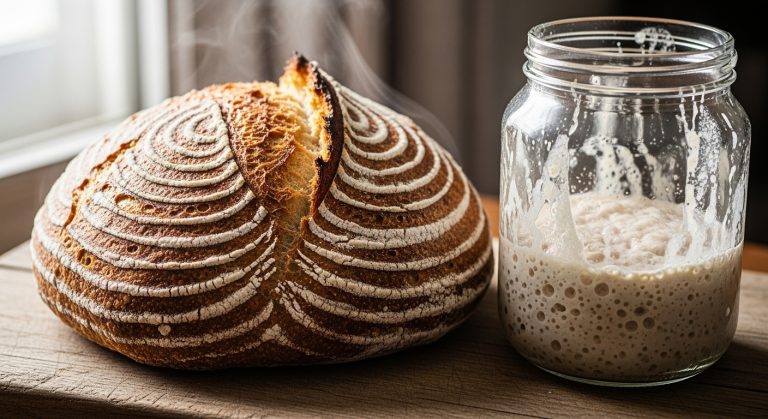Lavender Sourdough Bread: Aromatic Artistry
Ready to bake a mesmerizing lavender sourdough bread? Start with a lively levain, mixing 30g each of starter, flour, and water, and let it bubble at 75-80°F for 4-5 hours.
Combine bread flour, a hint of whole wheat, and finely ground dried lavender for floral magic. Ferment at 73°F, shape with care, and bake in a preheated 500°F Dutch oven for a crisp crust. Curious? There’s more to uncover.
Key Takeaways
- Lavender Sourdough Bread combines dried lavender with bread flour for a unique floral aroma.
- Prepare levain at 75-80°F for 4-5 hours until bubbly and doubled in size.
- Incorporate herbs like rosemary or lemon zest to enhance lavender’s vibrant flavor profile.
- Shape dough into a tight boule and proof at 80°F for 1-2 hours.
- Bake in a preheated Dutch oven at 500°F for a crispy crust.
Getting Started With Lavender Sourdough
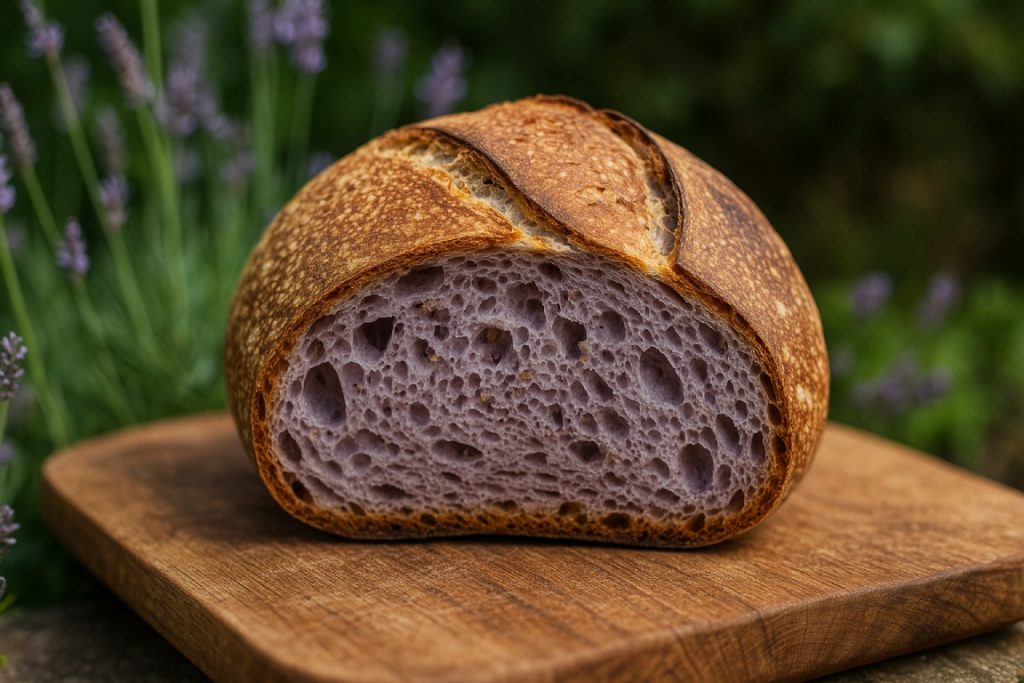
As you set out on your journey with lavender sourdough, let’s begin by preparing your levain—mix 30g each of sourdough starter, bread flour, and water, then cover and let it sit in a warm spot at 75-80ºF. Watch it bubble and double in size over 4-5 hours, a sign of vibrant fermentation ready to infuse your dough with complex flavors.
If you’re pressed for time, use 90g of active starter instead, skipping this build. This essential step guarantees a robust rise and depth in your bread. Remember that using a lively levain or active starter ensures consistent fermentation results.
Feel the excitement as you craft something extraordinary, harnessing fermentation’s magic to elevate your lavender sourdough to perfection! For precise measurements of your ingredients, consider using a high-capacity baking scale to ensure accuracy and consistency in every batch.
Essential Ingredients for the Recipe
Before you plunge into crafting your lavender sourdough bread, gather the essential ingredients that’ll bring this aromatic masterpiece to life. Start with flours—bread flour for structure, spelt or whole wheat for texture, or unbleached all-purpose for lightness. Embrace whole grain or seed spelt for depth and nutrition.
Infuse magic with dried lavender flowers, fresh rosemary, or thyme, and a hint of lemon zest for citrusy brightness. Add fresh garlic for savory warmth. Don’t skimp on sea salt or a touch of sugar for balance. Grab lukewarm water and olive oil for hydration, plus optional honey or lemon juice for flair. Remember to use about 10 cups of flour to ensure the dough achieves the right consistency. For optimal results, ensure your water is at the ideal temperature of 70-80°F to support fermentation.
Finally, make certain you’ve got an active sourdough starter ready to awaken the dough with tangy perfection.
Preparing the Levain Mixture
Now that you’ve gathered your ingredients for lavender sourdough bread, let’s get into the heart of the process by preparing the levain mixture. This step is where the magic begins, as the levain refines your starter, boosting flavor and rise.
Start with a clean container to avoid contamination, and mix 30g each of starter, flour, and water for a 100% hydration blend. Keep it in a warm spot, around 75-80°F, for 4-5 hours until it’s bubbly and doubled in size. Remember, the levain build time, ideally started at 10:30 a.m., ensures optimal fermentation timing for your dough. Using a reliable temperature control tool can help maintain consistent warmth for perfect results.
To perfect your levain, consider these tips:
- Monitor Ripeness: Check for a lively, frothy texture to ensure it’s ready.
- Adjust Flour: Try bread or Type 85 flour for unique depth.
- Control Temperature: Maintain 78°F for ideal fermentation.
Mixing and Fermenting the Dough
While the levain bubbles away, plunge into the next thrilling step of crafting your lavender sourdough bread by mixing and fermenting the dough. Grab your wheat bread flour and spelt flour, aiming for a hydration of 60-80%, and mix with a Danish dough whisk until combined.
Sprinkle in salt and 0.1-0.3g of freshly dried lavender, ground with a bit of flour for even distribution, balancing its floral intensity with spelt’s sweetness. Rest the dough briefly to integrate flavors. Remember that precise measurement of ingredients ensures consistent results for a well-balanced loaf.
Now, begin bulk fermentation at 23°C (73°F), covering the dough loosely for several hours. Watch for bubbles and a slight rise, using the slap and fold or stretch and fold method during rests to build strength and elasticity with passion. Maintain a consistent dough temperature around this range for optimal yeast activity and fermentation results.
Shaping Your Sourdough Loaf
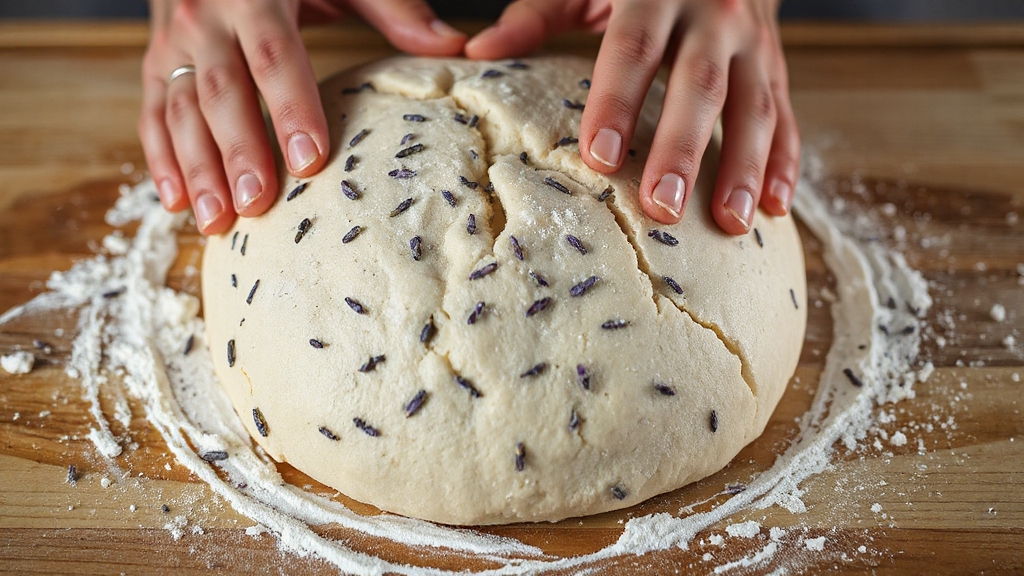
As the bulk fermentation wraps up, plunge into the art of shaping your lavender sourdough loaf with enthusiastic hands. Dust your clean, dry surface and hands with flour to prevent sticking, and wield a dough scraper if the dough clings stubbornly. Handle it gently—don’t tear the delicate structure you’ve nurtured. For best results, consider using rice flour in your banneton to prevent sticking issues. Timing is crucial, as shaping too late can disrupt the fermentation process timing and affect the final texture.
Shape swiftly to keep tension, crafting a boule by folding into a tight round or a batard with a long, even form.
Move quickly to maintain tension, shaping a boule into a snug round or a batard into a sleek, elongated form.
Dive deeper with these precise tips:
- Minimal Flour: Add just enough to maintain dough integrity without drying it out.
- Gentle Touch: Avoid over-working to preserve a tender crumb.
- Tight Shaping: Ensure a firm form for a stunning crust and bold oven spring.
Proofing Techniques for Best Results
After shaping your lavender sourdough loaf with care, turn your attention to the art of proofing, where patience and precision transform your dough into a masterpiece.
Control the environment meticulously—aim for 80°F (27°C) for a swift 1-2 hour proof, or opt for a cold refrigerator retard at 10-16 hours to deepen that floral lavender flavor.
Keep humidity high to prevent drying, using a proofing cabinet or a damp cloth in a warm kitchen. For best results, consider using unbleached parchment paper to line your proofing basket and avoid sticking during the process.
Monitor the dough’s volume closely; don’t let it overproof at warmer temps. Use the poke test to assess readiness—a slow spring back indicates your dough is perfectly proofed.
Handle it gently, and if you’ve added lavender post-autolyse, ensure it’s balanced.
Baking Methods for a Perfect Crust
Immerse yourself in the transformative stage of baking your lavender sourdough bread, where the right methods craft a crust that’s nothing short of perfection. Preheat your oven to 500ºF (260ºC) with a Dutch oven inside, ensuring even heat distribution. Start with a high blast for 20 minutes, trapping steam with the lid on for a crispy exterior. Additionally, consider preparing your dough ahead by shaping and freezing it overnight, as this helps maintain proper texture during baking.
Then, reduce the temperature to 450ºF (232ºC) after removing the lid for even baking. Rotate your loaf midway to promote uniform crust development and score it beforehand to guide expansion. For added convenience, try using a sourdough bread mix like Krusteaz to simplify the process while still achieving a delightful artisan crust.
Master these *essential* techniques for an impeccable crust:
- Steam Control: Use steaming pans initially, removing them after 20 minutes to crisp the surface.
- Hydration Balance: Adjust dough hydration for a lighter or denser crust.
- Cooling Precision: Cool properly post-baking to maintain crispiness.
Exploring Flavor Combinations
Hey, let’s uncover the magic of pairing lavender with herbs in your sourdough, where a pinch of lemon zest can elevate those delicate floral whispers into a vibrant symphony.
Don’t miss out on experimenting with fruit and nut pairings—imagine the sweet chew of dried apricots and the earthy crunch of walnuts melding flawlessly with lavender’s subtle charm.
Get ready to transform your loaf into a masterpiece by balancing these precise combinations with passion and creativity! Consider how incorporating flavored sourdough techniques can add unique dimensions to your lavender bread with complementary herbs and fruits.
Also, consider how lavender’s delicate flavor can shine in both the bread and a complementary glaze, enhancing overall taste.
Lavender and Herbs
How can you elevate your sourdough bread with an unexpected twist? Immerse yourself in the enchanting world of lavender and herbs, where floral notes meet earthy depth. You’ll find lavender’s subtle minty-rosemary essence, especially from culinary-grade Lavandula angustifolia, transforms your loaf with a balanced, aromatic flair. To further enhance the flavor, consider a longer cold fermentation process to develop deeper, more complex sour notes in your bread.
Pair it with herbs to amplify complexity—think rosemary’s piney bite or thyme’s savory warmth blending seamlessly into your dough. Lavender’s unique flavor profile, with hints of mint and rosemary, makes it an ideal match for dairy-based pairings or herbal infusions in bread recipes.
Explore these potent combinations to ignite your baking passion:
- Rosemary: Complements lavender’s minty undertones, crafting a rustic, aromatic bread.
- Thyme: Boosts savory depth, enhancing lavender’s floral charm in every bite.
- Sage: Adds herbal richness, perfect for a Mediterranean-style sourdough.
Fruit and Nut Pairings
Why not elevate your lavender sourdough bread with the vibrant interplay of fruit and nut pairings? Immerse yourself in the sweet chewiness of dried figs or tart cranberries, perfectly balanced by the earthy crunch of walnuts or pecans. You’ll love how these textures dance together, enhancing every bite with contrast and depth.
Experiment with classic combos like raisins and walnuts, or get adventurous with apricots and pumpkin seeds for a nutty-sweet thrill. Soak your fruits in black tea for complex depth, and don’t shy away from a hint of orange zest or cinnamon to amplify the warmth. Consider incorporating slivered almonds for added texture to bring an extra layer of crunch to your loaf.
Craft each loaf with passion, tailoring flavors to the season, and let your lavender sourdough become a masterpiece of taste and texture. For an inspired twist, try pairing your bread with olive oil and herbs, reminiscent of the rich flavors found in Parmesan Focaccia Bread.
Tips for Texture and Structure
As you explore crafting the perfect lavender sourdough bread, mastering texture and structure is key to achieving that coveted airy crumb and crisp crust. Focus on fermentation—keep your levain at 75-80°F for vibrant activity, and opt for slower, cooler bulk fermentation to build a robust structure.
Choose high-protein flours like King Arthur Bread Flour for volume, and don’t shy away from a touch of spelt for a nutty depth. Remember that proper proofing techniques can make a significant difference in the final loaf’s texture and rise (with proper proofing being essential to avoid overproofing or collapse).
Try these precise tips for exceptional results:
- Shape with Tension: Create tight surface tension during shaping to support a lofty rise.
- Score Shallowly: Use a lame for shallow cuts to ensure even expansion.
- Bake with Steam: Use a Dutch oven to trap moisture for a crisp crust.
Frequently Asked Questions
How Long Does Lavender Sourdough Bread Stay Fresh?
Hey, you’re curious about how long certain baked goods stay fresh, aren’t you? Let’s delve in with fervor!
Typically, you’ll find that naturally fermented loaves keep their delightful texture for 3-5 days at room temp (18-20°C).
With lavender sourdough bread, you’re in that same window—its unique aroma doesn’t change the game. Store it right, and savor every bite within those first few days for peak perfection!
Can Lavender Sourdough Be Frozen for Later Use?
Hey, you’re wondering if you can freeze bread for later use? Absolutely, you can! Plunge into the process with zeal—cool your loaf completely to lock in that perfect texture, then seal it tight in a ziplock bag.
Freeze whole or in slices for ultimate convenience. You’ve got 4-8 weeks to enjoy peak freshness, so don’t wait! Thaw at room temp and savor every bite with passion!
Is Lavender Sourdough Suitable for Dietary Restrictions?
Hey, when you’re steering through dietary restrictions, you’ve gotta dig deep into what works for you! Consider gluten sensitivity—sourdough’s fermentation can ease digestion, but it’s not gluten-free. If you’re vegan, you’re likely in the clear with plant-based ingredients.
Low-carb? Watch out, as carbs are still high despite a lower glycemic index. For gut health, you’ll love the prebiotic benefits. Immerse yourself, check ingredients, and tailor it to your needs with passion!
How to Store Lavender Sourdough Bread Properly?
Hey, you’ve gotta treat your bread like it’s a priceless treasure, guarding it against the cruel world of staleness! Store it passionately at room temperature for up to three days, using a bread box or bag to lock in moisture.
Don’t even think about refrigeration—it’ll suck the life out! Keep it in a dry spot, cut-side down if sliced, and wrap it tight to preserve every crumb’s perfection.
Can I Use Fresh Lavender Instead of Dried?
Hey, you can absolutely use fresh lavender instead of dried in your baking adventures! Immerse yourself in this with passion—fresh lavender offers a lighter, floral burst, but it’s less potent, so triple the amount compared to dried.
Process it well, maybe infuse it in liquid for 15-30 minutes, and strain carefully. You’ll nail a delicate flavor balance, crafting something truly unique.
Go create with bold confidence!
Rustic Beauty: Lavender Sourdough That Delights
You’ve just crafted a lavender sourdough masterpiece—earthy yet floral, rustic yet refined. Enjoy the delightful contrast of a crisp, golden crust with a tender, aromatic crumb.
Your kitchen is now a haven of warmth, filled with creativity and comfort in every slice. Continue experimenting, exploring new flavors, and perfecting your technique.
Let your passion transform each loaf into edible art. Before long, you’ll be baking not just bread, but lasting memories, as sweet and lingering as the scent of lavender itself.

